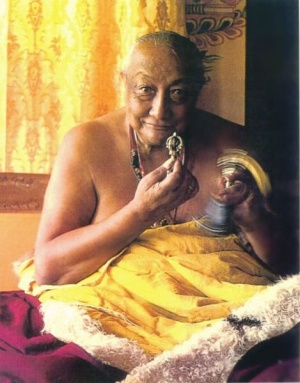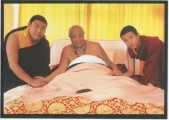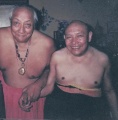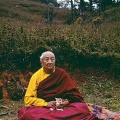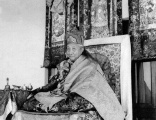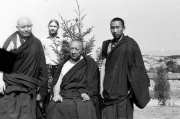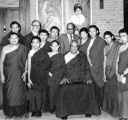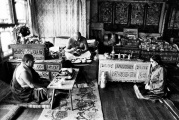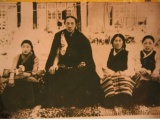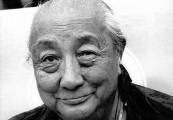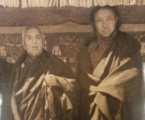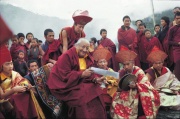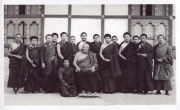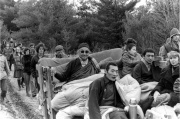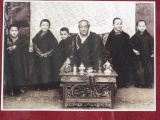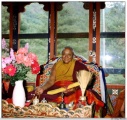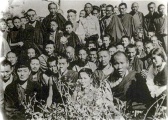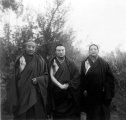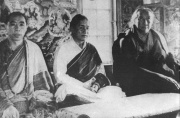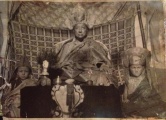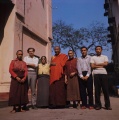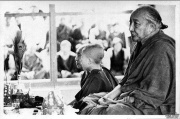Difference between revisions of "Dilgo Khyentse"
m (Text replacement - "]]]" to "]])") |
|||
| Line 121: | Line 121: | ||
* ''[[Journey to Enlightenment]]: The [[Life]] and [[World]] of [[Khyentse Rinpoche]], [[Spiritual Teacher]] from [[Tibet]]'' | * ''[[Journey to Enlightenment]]: The [[Life]] and [[World]] of [[Khyentse Rinpoche]], [[Spiritual Teacher]] from [[Tibet]]'' | ||
| − | : by [[Matthieu Ricard]] (Photographer) [[Dilgo Khyentse Rinpoche's]] [[disciple]] | + | : by [[Matthieu Ricard]] (Photographer) [[Dilgo Khyentse Rinpoche's]] [[disciple]]), [[Rab-Gsal-Zla-Ba]], [[Padmakara Translation Group]] ([[Translator]]) |
: Hardcover: 151 pages; Publisher: Aperture | : Hardcover: 151 pages; Publisher: Aperture | ||
: 1st ed edition (October 1, 1996) | : 1st ed edition (October 1, 1996) | ||
Latest revision as of 02:54, 4 April 2016
Dilgo Khyentse Rinpoche (Tibetan: དིལ་མགོ་མཁྱེན་བརྩེ་, Wylie: dil mgo mkhyen brtse) (c. 1910 – 28 September 1991) was a Vajrayana master, scholar, poet, teacher, and head of the Nyingma school of Tibetan Buddhism from 1987 to 1991.
Biography
He was born in the Denhok Valley at Kham Derge, Eastern Tibet in 1910 to a family directly descended from the ninth century King Trisong Detsen.
His father was a minister to the King of Derge.
When he was seven years old, he was publicly recognized as one of the reincarnations of Jamyang Khyentse Wangpo by Shechen Gyaltsap Rinpoche (1871–1926) at Shechen, one of the six principal monasteries of the Nyingmapa school.
During the next few years Dilgo Khyentse received full schooling from various tutors, in addition to training in meditation, and in the study of the Dharma in general, and of Tantra specifically.
His root Guru was Shechen Gyaltsap Rinpoche, and Dzongsar Khyentse Chokyi Lodro (1893–1959) was his other main spiritual master.
After he completed what are known as the Preliminary Practices (Ngöndro), Khyentse Rinpoche spent most of the next thirteen years in silent retreat in remote hermitages and caves near his birthplace.
After completing his retreat at the age of twenty-eight, Khyentse Rinpoche spent many years with Dzongsar Khyentse Chokyi Lodro.
After receiving from Khyentse Chokyi Lodro the many empowerments of the Rinchen Terdzo (the collection of Revealed Treasures or termas), Dilgo Khyentse requested to spend the rest of his life in solitary meditation.
But Khyentse Chokyi Lodro's answer was: "The time has come for you to teach and transmit to others the countless precious teachings you have received."
Additionally he received teachings at Palpung Monastery from the eleventh Tai Situ Rinpoche, and full instruction on the ancient Guhyagarbha Tantra and its various commentaries from Khenpo Tubga at Kyangma Ri-tro.
In all he studied with over fifty great teachers from all the various oral and practice lineages of Tibetan Buddhism.
As his own teaching career developed, he became renowned within Tibet for his ability to transmit the teachings of each Buddhist lineage according to its own tradition.
Later on His Holiness the Dalai Lama would regard Dilgo Khyentse Rinpoche as his principal teacher in the Nyingma tradition and of Dzogchen.
In the 1950s, as rebellions broke out in Kham in response to the imposition of Chinese Communist rule, Khyentse Rinpoche and his family escaped to central Tibet, leaving behind his precious library of collected Dharma books and most of his own writings.
Then in 1959, after the 14th Dalai Lama left Tibet, Khyentse Rinpoche, his family and a few disciples decided to leave Tibet, including his brother the 9th Sangye Nyenpa Rinpoche and Tenga Rinpoche, and headed for Bhutan.
The royal family of Bhutan invited him to stay there and teach, and as his reputation spread he attracted many new disciples, and he became the foremost Buddhist teacher in Bhutan.
Later, as he made frequent visits to give teachings to H.H. the 14th Dalai Lama at Dharamasala in India, he began giving teachings all over the Himalayas, India, Southeast Asia and the West.
His life became a continual flow of teaching, yet he found time for extensive scholarship and composed numerous poems, meditation texts and commentaries.
He was also a Terton (a discoverer of spiritual treasures), discovering numerous termas and was one of the leading masters of the pith-instructions of Dzogchen, the Great Perfection, and one of the principal holders of the Longchen Nyingtik tradition.
In 1980, he founded the Shechen Tennyi Dargyeling Monastery in Nepal, where he transplanted the Shechen tradition to a new home near the great stupa of Boudhanath, just northeast of Kathmandu.
At this location over the years he gave many teachings, turning the wheel of the Dharma countless times for hundreds of other lamas, disciples, and students from around the world.
Over this same time period, and up until his paranirvana in 1991, Dilgo Khyentse Rinpoche was involved in publishing as much of Tibet’s extraordinary heritage of Buddhist teachings as possible, over three hundred volumes altogether.
By followers of Tibetan Buddhism he is regarded as having been a great teacher of teachers, a realized being, who was also remarked upon as being a genuinely good human being.
His entire life was devoted to the preservation and dissemination of the Buddha Dharma and he is still regarded with awe and amazement throughout the Tibetan diaspora, and western centers of Tibetan Buddhism.
His importance within the Nyingma school in the 20th century was all-pervading.
He was one of the few Tibetan Lamas accorded the honorific title of "His Holiness".
Following the death of Dudjom Rinpoche in 1987, he became the head of the Nyingma School, and remained so until his own death in Bhutan on 28 September 1991.
Final cremation ceremonies were held for him over a three day period near Paro in Bhutan, in November 1992 and were attended by over a hundred important lamas, the Royal Family and ministers of Bhutan, five hundred western disciples and a huge crowd of some fifty thousand devotees.
Preservation of lineages
Gyatrul (b.1924), in a purport to Karma Chagmé (Wylie: karma-chags-med, fl. 17th century), conveys Khyentse's 'samaya' (Sanskrit), diligence and humility in receiving 'wang' (Tibetan), lineal transmission and 'rlung' (Wylie) as rendered into English by Wallace (Chagmé et al., 1998: p. 21):
- With respect to oral transmission, even if the lineage is impure, it is not a problem.
Dilgo Khyentse Rinpoche often sought out and received any oral transmission he thought was on the verge of disappearing.
It made no difference who was giving it.
He would receive it and, in turn, pass it on to make sure that the lineage remained unbroken.
Dilgo Khyentse Yangsi Rinpoche
Dilgo Khyentse Yangsi Rinpoche, who currently resides in Bhutan, was appointed as the incarnation of Dilgo Khyentse Rinpoche on December 1995:
- Khyentse Yangsi Rinpoche was born in Nepal on June 30, 1993.
When Khyentse Rinpoche passed away, his close students requested Trulshik Rinpoche, his most senior and accomplished disciple, to find his incarnation.
Film
The film "Spirit of Tibet: Journey to Enlightenment, The Life and World of Dilgo Khyentse Rinpoche" was released in 1998.
It was made by Matthieu Ricard (French photographer, Buddhist monk, and author) who had travelled with Khyentse Rinpoche for 14 years.
It tells Khyentse Rinpoche's story from birth to death, to rebirth, and of his escape following China's invasion of Tibet to his determination to preserve and transmit Buddhist teachings far and wide.
The film reveals Tibet's art, ritual philosophy, and sacred dance.
Along with rarely photographed areas of Tibet, Bhutan and Nepal, this film features interviews with the Dalai Lama, who speaks about his own spiritual life.
Publications
- Enlightened Courage: An Explanation of Atisha's Seven Point Mind Training
- by Rab-Gsal-Zla-Ba, Dilgo Khyentse Rinpoche
- Paperback: 120 pages; Publisher: Snow Lion Publications
- (December 1, 1993)
- Guru Yoga : According to the Preliminary Practice of Longchen Nyingtik
- by Rab-Gsal-Zla-Ba, Matthieu Ricard, Dilgo Khyentse Rinpoche, Rigpa
- Paperback: 101 pages; Publisher: Snow Lion Publications
- (December 1, 1999)
- Journey to Enlightenment: The Life and World of Khyentse Rinpoche, Spiritual Teacher from Tibet
- by Matthieu Ricard (Photographer) Dilgo Khyentse Rinpoche's disciple), Rab-Gsal-Zla-Ba, Padmakara Translation Group (Translator)
- Hardcover: 151 pages; Publisher: Aperture
- 1st ed edition (October 1, 1996)
- by H.H. Dilgo Khyentse Rinpoche
- Paperback: 128 pages; Publisher: Snow Lion Publications
- (April 1, 1996)
- by Dilgo Khyentse Rinpoche, Patrul Rinpoche (Foreword by H.H. the Dalai Lama)
- Paperback: 280 pages; Publisher: Shambhala
- The Hundred Verses of Advice : Tibetan Buddhist Teachings on What Matters Most
- by Dilgo Khyentse Rinpoche, Padama Sangye
- Hardcover: 176 pages; Publisher: Shambhala
- (February 15, 2005)
- The Lotus-Born: The Life Story of Padmasambhava
- by Erik Pema Kunsang, His Holiness Dilgo Khyentse Rinpoche, Tsele Natsok Rangdrol, Yeshe Tsogyal
- Paperback: 336 pages; Publisher: North Atlantic Books, Rangjung Yeshe
- (October 10, 2004)
- by Dilgo Khyentse Rinpoche
- Paperback: 120 pages; Publisher: Shambhala;
- Reprint edition (March 16, 1999)
- The Collected Works of Dilgo Khyentse Vols. 1-3
- by Dilgo Khyentse Rinpoche
- Hardcover: 1808 pages; Publisher: Shambhala; (January 11, 2011)
- 1st edition
Dilgo Khyentse Rinpoche with Rabin Losal
